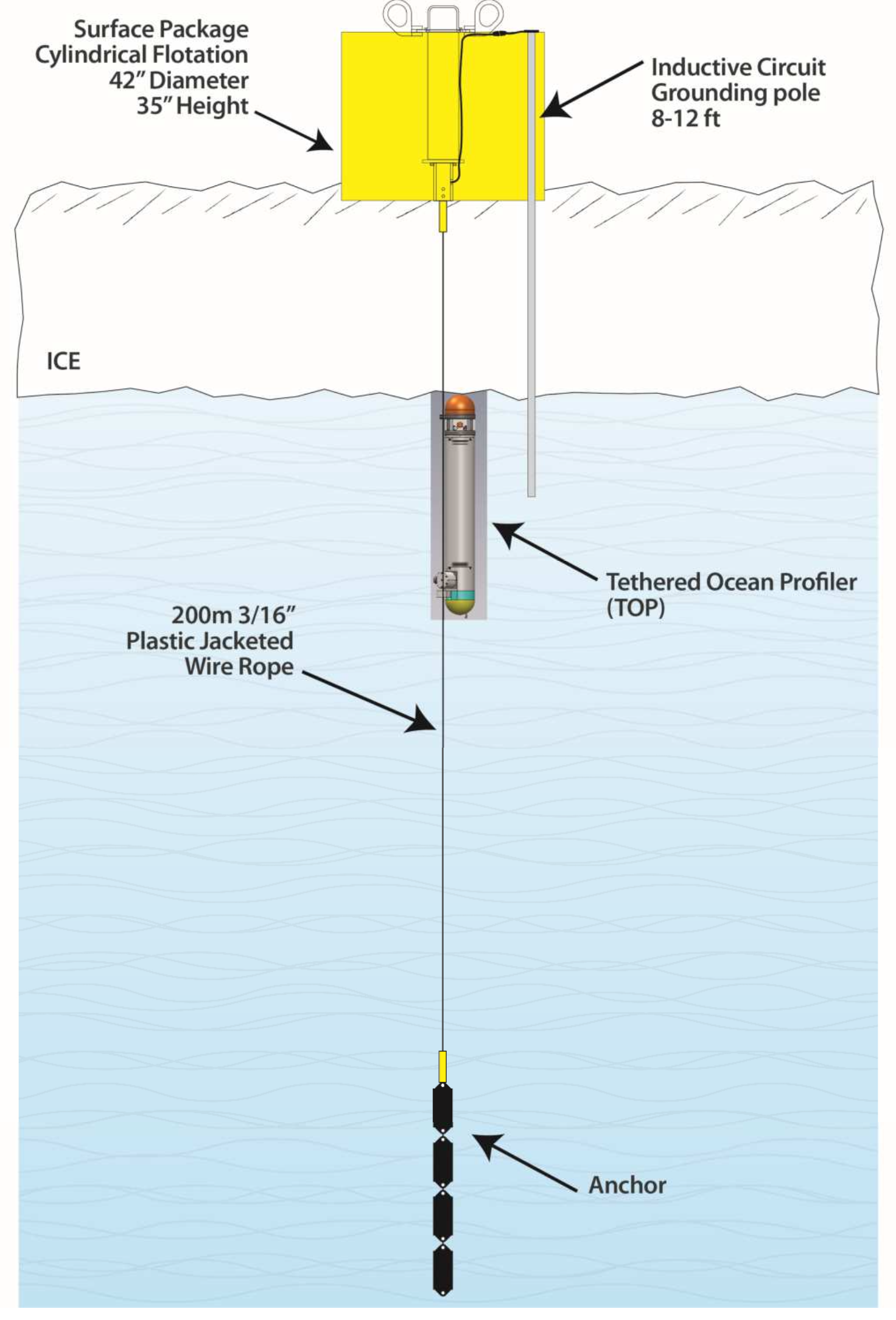Tethered Ocean Profiler (TOP) Technology
Introduction
A complete description of the Tethered Ocean Profiler (TOP) technology is provided in O'Brien et al. 2023, down-loadable to the right.
The TOP system consists of the same three components the ITP: a surface instrument package that sits atop an ice floe or floats in open water, a weighted wire-rope tether of arbitrary length (up to 800 m) suspended from the surface package, and an instrumented profiler that travels up and down the wire tether. A schematic drawing of the instrument is given to the right.
TOP has additional functionality compared to the ITP, with improvements in operations, scientific capability, and cost. Highlights are provided below, and include the ability to sample within 20 cm of the ice-ocean interface, and ability to profile at times of strong ice floe drift and during times of reduced wire tension when encountering shallow topography.
The first TOP systems had a 200 m operating depth (and were co-deployed with ITPs). TOP is now operational with an 800 m tether. Upward and downward profiles are completed in a single action, with a short pause of a few minutes at the shallowest depth, as shown in the example profiling schedule to the right.
TOP Profiler Enhancements
- High quality data during both up and down profiles as the CTD sensor is mounted on the side of the profiling vehicle versus the ITPs upward-facing sensor.
- Sampling to within 20 cm of the ice-ocean interface as the TOP profiler can gently bump into the ice base without damaging the side-mounted sensors.
- Improved vertical resolution as the TOP profiler traverses the tether at 17cm/s versus 25 cm/s for ITP. The profiler also slows to half speed starting at a user-defined distance below the ice to gently bump the ice base, which also doubles the vertical sampling resolution in the uppermost few meters.
- CTD sensors are sampling at 2 or 3 Hz versus 1 Hz for ITP. This coupled with 17 cm/s profiler speed provides ~10-17 samples per meter versus ITP's 4 samples per meter.
- Improved profiling at times of rapid ice drift or when encountering topography shallower than 800 m by using a pinch-roller drive system to better propel the profiler up the tether. This greatly reduces the failure risk when encountering topography.
- Inductive modem transmissions at 5x the speed of ITP by using a new inductive modem technology from Soundnine, Inc. This lessens power-on time for both the profiler and surface package which improves operational endurance.
- Unlike ITP, the external Soundnine inductive modem mooring coupler cabling is all internal and reduces the risk of cable snags and general cable fouling related issues possible with ITP.
- The TOP controller is a more capable Linux-based single board computer utilizing bzip2 compression to further decrease power-on time by reducing the number of bytes transmitted inductively.
- The Linux controller also logs sensor output streamed directly to the controller and uses a universal timestamp for sensor recordings. This improves endurance by negating the need to offload data from each sensor at the conclusion of each profile before inductive transmission. Universal time stamping simplifies data processing for systems fitted with multiple, independent sensors.
TOP Tether and Buoy Enhancements
- Eliminated the original ITP tether potted section of wire and inductive modem circuit upper grounding contact in favor of a grounding rod system. This allows the TOP profiler to travel all the way to the ice-ocean interface.
- The grounding rod mounting hole is molded into the periphery of the surface buoy flotation.
- New simple cylindrical surface buoy shape which lowers cost.

Related Files
Tethered Ocean Profiler, TOP
by J.K. O'Brien, R.A. Krishfield, M.-L. Timmermans, and J.M. Toole (2023), Proc. IEEE Oceans 2023-Limerick, 10 pages, doi:10.1109/OCEANSlimerick52467.2023.10244491.